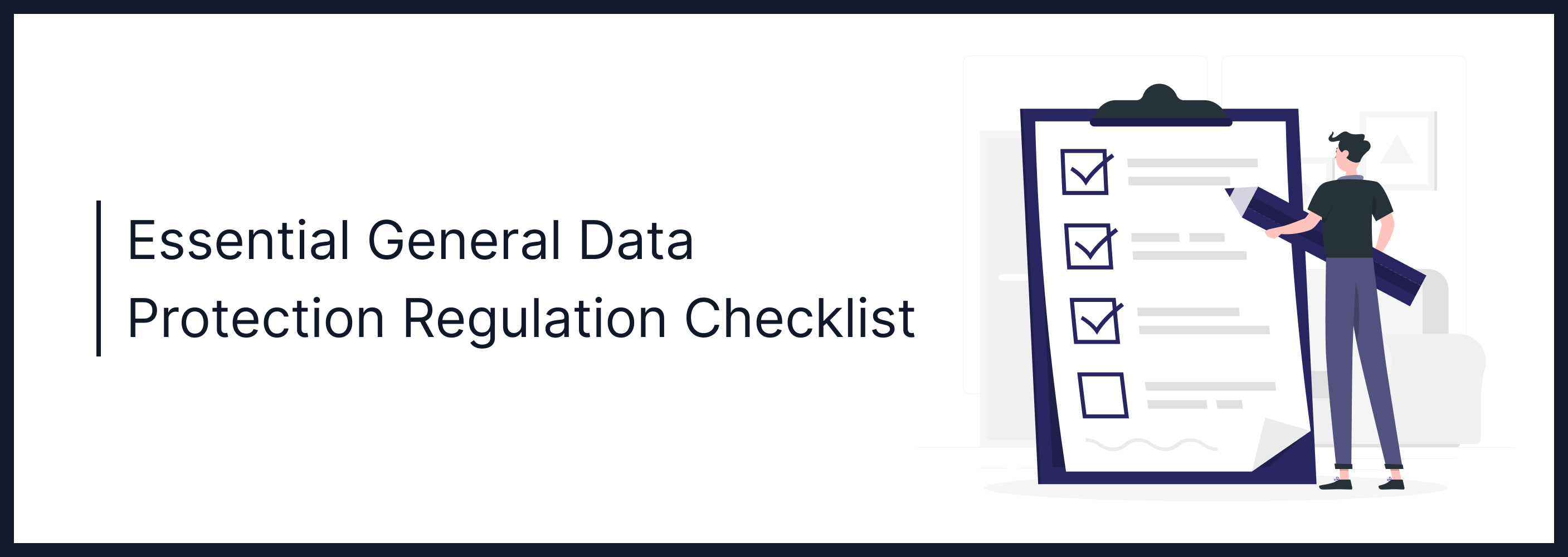
Oct 15, 2024 Information hub
Essential General Data Protection Regulation Checklist for Business Compliance
In today’s digital age, data is one of the most valuable assets for businesses. However, with the increasing reliance on data comes the responsibility to protect it. The General Data Protection Regulation (GDPR) is a landmark legislation that was introduced by the European Union (EU) in May 2018 to safeguard personal data and ensure privacy for individuals within the EU. It has since become a global standard for data protection, influencing regulations worldwide.
For businesses, compliance with GDPR is not just a legal obligation but also a critical factor in building trust with customers. Failing to comply can result in hefty fines, reputational damage, and loss of customer trust. This is where a General Data Protection Regulation checklist becomes essential. A well-structured checklist helps businesses ensure they meet all the necessary requirements and avoid potential pitfalls.
In this blog post, we will explore the significance of GDPR, break down the key components of a GDPR checklist, and provide actionable insights to help businesses navigate the complexities of data protection.
Why GDPR Matters Today
The Growing Importance of Data Privacy
In an era where data breaches and cyberattacks are becoming increasingly common, data privacy has never been more important. According to a report by IBM, the average cost of a data breach in 2022 was $4.35 million, a figure that continues to rise annually. GDPR was introduced to address these growing concerns by giving individuals more control over their personal data and holding businesses accountable for how they handle it.
Global Influence of GDPR
Although GDPR is an EU regulation, its impact extends far beyond Europe. Any company that processes the personal data of EU citizens, regardless of where the company is based, must comply with GDPR. This has led to a ripple effect, with countries like Brazil, Japan, and South Korea adopting similar data protection laws. Even in the United States, states like California have introduced the California Consumer Privacy Act (CCPA), which mirrors many of GDPR’s principles.
The Consequences of Non-Compliance
Non-compliance with GDPR can result in severe penalties. The regulation allows for fines of up to €20 million or 4% of a company’s global annual turnover, whichever is higher. In 2021, Amazon was fined a record €746 million for GDPR violations, highlighting the serious financial risks involved. Beyond fines, non-compliance can lead to reputational damage, loss of customer trust, and legal challenges.
The General Data Protection Regulation Checklist
To help businesses navigate GDPR compliance, we’ve compiled a comprehensive General Data Protection Regulation checklist. This checklist covers the key areas that businesses need to focus on to ensure they meet GDPR requirements.
1. Data Mapping and Inventory
Before you can protect personal data, you need to know what data you have and where it’s stored. Data mapping involves identifying all the personal data your organization collects, processes, and stores. This includes data from customers, employees, suppliers, and any other stakeholders.
Key Steps:
- Identify all data sources: This includes databases, cloud storage, email systems, and physical records.
- Classify data: Determine what constitutes personal data under GDPR. This includes names, email addresses, IP addresses, and any other information that can identify an individual.
- Document data flows: Understand how data moves through your organization, from collection to storage and eventual deletion.
Practical Example:
A retail company that collects customer data through online purchases would need to map out how that data is collected (e.g., through a website form), where it is stored (e.g., in a cloud database), and how it is used (e.g., for marketing purposes).
2. Legal Basis for Data Processing
Under GDPR, businesses must have a valid legal basis for processing personal data. There are six lawful bases for processing data, including consent, contract performance, legal obligation, vital interests, public task, and legitimate interests.
Key Steps:
- Determine the legal basis: For each type of data processing, identify the appropriate legal basis.
- Obtain consent where necessary: If you rely on consent as the legal basis, ensure that it is freely given, specific, informed, and unambiguous.
- Document your legal basis: Keep records of the legal basis for each data processing activity.
Practical Example:
An e-commerce company that sends marketing emails to customers must ensure that it has obtained explicit consent from those customers to use their email addresses for marketing purposes.
3. Data Subject Rights
GDPR grants individuals several rights regarding their personal data, including the right to access, rectify, erase, and restrict processing of their data. Businesses must have processes in place to respond to these requests in a timely manner.
Key Steps:
- Implement procedures for handling requests: Ensure that your organization can respond to data subject requests within the required timeframe (usually one month).
- Provide clear communication: Inform individuals of their rights in your privacy policy and other communications.
- Train staff: Ensure that employees understand how to handle data subject requests.
Practical Example:
A customer contacts a company to request the deletion of their personal data. The company must have a process in place to verify the request, delete the data, and inform the customer that the request has been fulfilled.
4. Data Protection Impact Assessments (DPIAs)
A Data Protection Impact Assessment (DPIA) is required when data processing is likely to result in a high risk to the rights and freedoms of individuals. DPIAs help organizations identify and mitigate risks associated with data processing activities.
Key Steps:
- Identify high-risk processing activities: This includes activities such as large-scale processing of sensitive data or systematic monitoring of individuals.
- Conduct a DPIA: Assess the potential risks and implement measures to mitigate them.
- Document the DPIA: Keep a record of the assessment and any actions taken to address the risks.
Practical Example:
A healthcare provider that processes large amounts of sensitive patient data would need to conduct a DPIA to assess the risks and ensure that appropriate safeguards are in place.
5. Data Breach Notification
GDPR requires businesses to report certain types of data breaches to the relevant supervisory authority within 72 hours of becoming aware of the breach. In some cases, businesses must also notify the affected individuals.
Key Steps:
- Implement a data breach response plan: Ensure that your organization has a clear process for identifying, reporting, and responding to data breaches.
- Train employees: Make sure that staff are aware of the procedures for reporting data breaches.
- Notify the relevant parties: If a breach occurs, notify the supervisory authority and affected individuals as required.
Practical Example:
A financial services company experiences a data breach that exposes customer credit card information. The company must notify the relevant data protection authority and inform the affected customers within 72 hours.
6. Data Retention and Deletion
GDPR requires businesses to retain personal data only for as long as necessary for the purposes for which it was collected. Once the data is no longer needed, it must be securely deleted.
Key Steps:
- Establish data retention policies: Define how long personal data will be retained and when it will be deleted.
- Implement secure deletion methods: Ensure that personal data is securely deleted when it is no longer needed.
- Regularly review data retention practices: Periodically review your data retention policies to ensure compliance with GDPR.
Practical Example:
A recruitment agency collects personal data from job applicants. Once the recruitment process is complete, the agency must delete the data of unsuccessful applicants unless they have obtained consent to retain it for future opportunities.
7. Data Protection Officer (DPO)
Under GDPR, certain organizations are required to appoint a Data Protection Officer (DPO). This includes public authorities and organizations that engage in large-scale processing of sensitive data.
Key Steps:
- Determine if you need a DPO: Assess whether your organization is required to appoint a DPO based on the nature of your data processing activities.
- Appoint a qualified DPO: The DPO should have expert knowledge of data protection laws and practices.
- Ensure independence: The DPO should operate independently and report directly to the highest level of management.
Practical Example:
A large hospital that processes sensitive patient data appoints a DPO to oversee its data protection practices and ensure compliance with GDPR.
Current Trends, Challenges, and Future Developments
Trends in Data Protection
- Increased Focus on Data Minimization: Businesses are increasingly adopting data minimization practices, collecting only the data they need and reducing the risk of data breaches.
- AI and Data Privacy: The rise of artificial intelligence (AI) presents new challenges for data privacy, as AI systems often require large amounts of personal data for training and decision-making.
- Cross-Border Data Transfers: With the invalidation of the EU-US Privacy Shield, businesses are facing new challenges in transferring data between the EU and the US. The introduction of new frameworks, such as the EU-US Data Privacy Framework, is expected to address these challenges.
Challenges in GDPR Compliance
- Complexity of Compliance: For many businesses, especially small and medium-sized enterprises (SMEs), navigating the complexities of GDPR can be overwhelming.
- Evolving Regulatory Landscape: As data protection laws continue to evolve, businesses must stay up to date with new regulations and ensure ongoing compliance.
Future Developments
- Stronger Enforcement: As data protection authorities become more experienced with GDPR, we can expect to see stronger enforcement and higher fines for non-compliance.
- Global Data Protection Standards: GDPR has set the standard for data protection worldwide, and we are likely to see more countries adopting similar regulations in the future.
Conclusion
The General Data Protection Regulation checklist is an essential tool for businesses to ensure compliance with GDPR and protect the personal data of their customers, employees, and other stakeholders. By following the steps outlined in this checklist, businesses can mitigate the risks of non-compliance, avoid hefty fines, and build trust with their customers.
Actionable Takeaways:
- Conduct a thorough data mapping exercise to understand what personal data you collect and how it is processed.
- Ensure that you have a valid legal basis for processing personal data and obtain consent where necessary.
- Implement procedures to handle data subject requests and respond to data breaches in a timely manner.
- Regularly review your data retention policies and securely delete data when it is no longer needed.
- Appoint a Data Protection Officer if required and ensure they have the necessary expertise and independence.
By staying proactive and vigilant, businesses can navigate the complexities of GDPR and ensure that they are well-prepared for the future of data protection.
